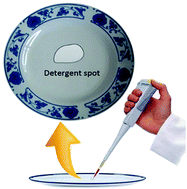Dish detergents help keep our dishes clean; however, the long term health effects of detergent residues on tableware and cookware is yet to be discussed publicly. Studies suggest that certain household detergents may be linked with disturbances in hormone regulation in humans.
As a first step in uncovering the role of domestic dish detergent in affecting health, a research team comprising scientists from China Agricultural University, China Research Center of Intelligent Equipment for Agriculture, and Beijing Academy of Agriculture and Forestry Sciences, have developed a method to detect detergent residue rapidly and in real-time, i.e., the process does not involve dissolving, preparing, or conditioning the residue prior to detection.
This method is based on a process called Laser Induced Breakdown Spectroscopy (LIBS). Detergent residues are first vaporized by a high-power laser, leading to the generation of vaporized plasma. At the end of the laser pulse, these atoms and ions spontaneously return from a higher energy state to a lower energy state. This energy decay is associated with the emission of optical radiation of specific wavelengths. The emitted radiation is collected and channeled toward a spectrometer, which converts wavelength information into readable numbers that scientists can record and analyze.
Although the LIBS technology has existed for several years, and is used routinely by researchers in the field, this study let by Zhao an colleagues is the first to use this method to measure household detergents.
Analogous to how a sensor at a grocery store is programmed to recognize barcodes printed on different items, the scientists used the numbers generated by the spectrometer to generate ‘signatures’ to help them recognize the different detergents used in the study. Using this method, the team found that detergent detection in real-time can be more flexible, used with tableware of different shapes, used to measure trace amounts of detergent, compatible with dry and wet dishes, and safe on tableware.
To demonstrate the utility of the method to real world applications, the team conducted a series of timed dish washes and residue analyses. Their results suggest that a 16-minute rinse removes detergent residues. They also suggest that this information will be useful in designing and programming commercial dishwashers.
This study may someday inspire public health advocates to take a closer look at the prevalence of dish residues in public and household settings. When this day arrives, LIBS technology for residue detection may be pivotal in conducting studies to better understand the relationship between dish residues and overall wellbeing.
Read the full article here:
Detection of domestic detergent residues on porcelain tableware using laser induced breakdown spectroscopy
Xiande Zhao, Daming Dong, Yang Lic and Chunjiang Zhao
RSC Adv., 2017, 7, 28689-28695 (Open Access)











